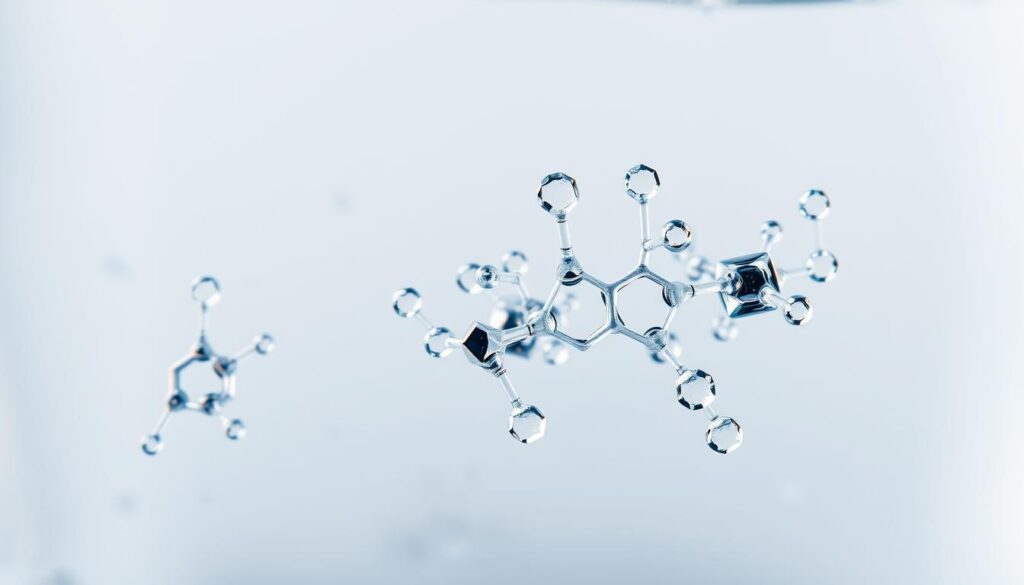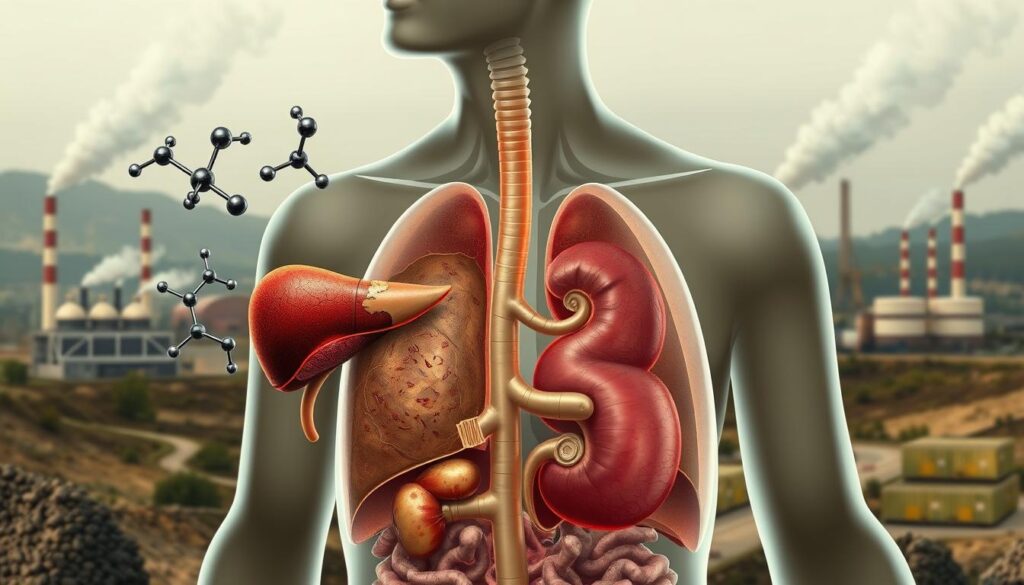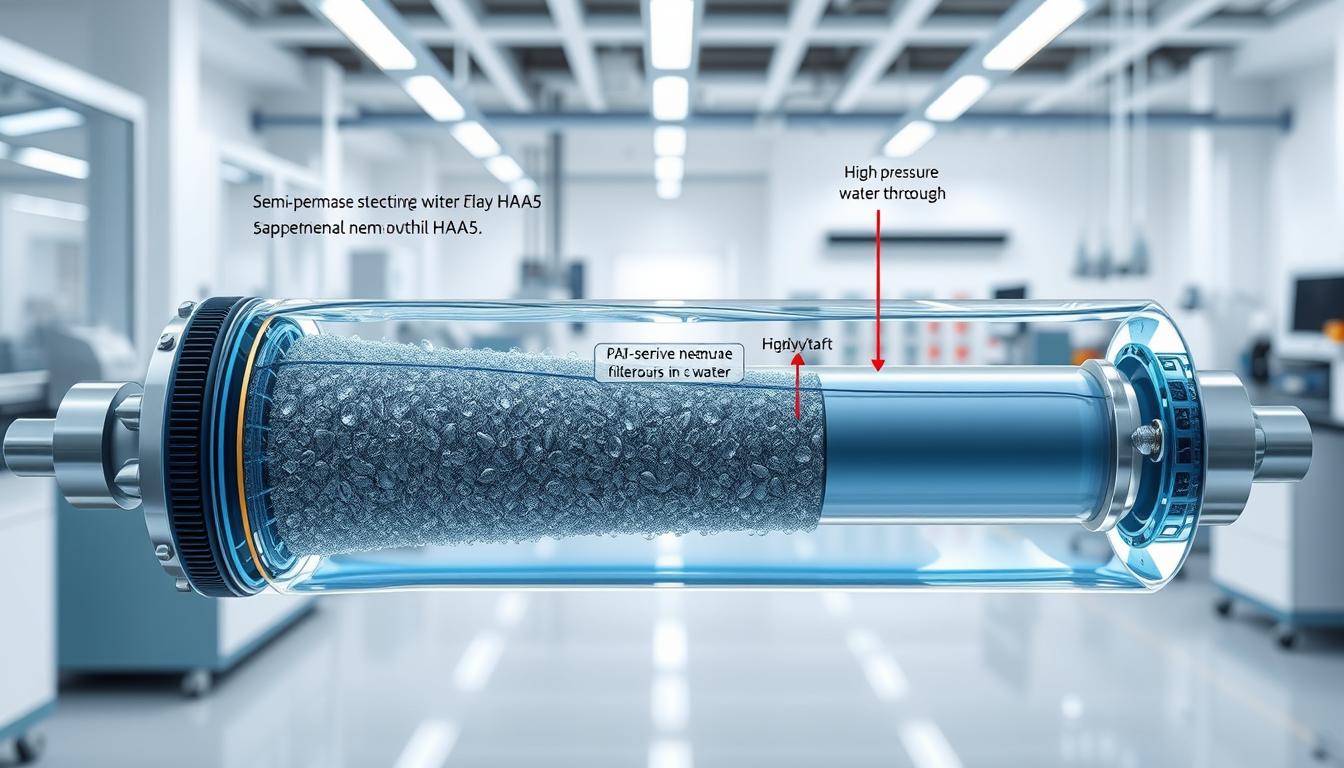We’ve all stood at the kitchen sink, watching clear liquid fill our glasses, wondering: “Is this truly safe?” For millions of Americans, that simple act of pouring a drink carries quiet concerns about what might linger in their tap water.
Recent studies reveal troubling levels of disinfection byproducts like HAA5 in municipal supplies. These compounds form when chlorine reacts with organic matter – a necessary evil for killing pathogens, but one with unintended consequences. Long-term exposure has been linked to serious health risks that no family should ignore.
This guide cuts through the confusion about water treatment. We’ll explain why reverse osmosis stands apart in eliminating stubborn contaminants, including haloacetic acids that simpler pitchers and faucet attachments often miss. Later sections explore how CovePure’s innovative membrane technology pushes purification further than standard systems.
You’ll discover:
- How certified systems meet NSF/ANSI standards for contaminant removal
- Critical differences between filtration methods
- Actionable steps to verify your water quality
Knowledge transforms anxiety into empowerment. Let’s begin unraveling the science behind cleaner, safer hydration.
Understanding HAAs in Our Water Supply
Municipal systems walk a tightrope between safety and unintended consequences. Disinfection remains vital for destroying harmful pathogens, but the chemical reactions involved create complex trade-offs. When chlorine interacts with decaying leaves, algae, or agricultural runoff in water sources, it forms stubborn byproducts scientists call haloacetic acids.

The Chemistry Behind Contaminant Creation
Organic materials like soil particles or dissolved plant matter act as building blocks for these compounds. Warmer temperatures and slower-moving tap water in distribution pipes accelerate their development. A 2021 EPA report found higher HAA5 concentrations in regions with aging infrastructure and heavy fertilizer use.
Balancing Act in Treatment Facilities
Water plants constantly adjust chlorine levels to minimize risks while maintaining protection against bacteria. Though necessary, this process explains why 12% of U.S. systems exceeded HAA5 limits in 2022 according to federal data. Residual disinfectants themselves aren’t the primary concern—it’s their interaction with environmental factors that matters most.
Many assume clearer liquid means purer hydration, but dissolved substances don’t alter appearance. Peer-reviewed studies show conventional filtration methods often miss these microscopic acids, leaving them present at detectable levels in treated supplies. As research continues, one truth emerges: our defense against waterborne illnesses sometimes carries hidden costs.
Navigating the Risks of Haloacetic Acids
Long-term health implications often hide in plain sight within our daily hydration. Research shows these byproducts accumulate in the body over decades, creating risks that surface long after initial exposure. A 2023 Johns Hopkins study found individuals consuming affected drinking water for 10+ years faced 34% higher odds of developing bladder issues.

Chronic Exposure and Associated Health Risks
Peer-reviewed data reveals troubling connections between prolonged contact with these compounds and cellular damage. The liver and kidneys work overtime to process them, potentially leading to organ stress. Three key findings from recent analyses:
- 15-year exposure correlates with 28% increased cancer likelihood (Environmental Health Perspectives)
- Developmental impacts observed in animal studies at EPA-approved concentration levels
- Synergistic effects when combined with other common contaminants
Unlike temporary pollutants, these byproducts resist natural breakdown. Their persistence means even trace amounts in drinking water contribute to cumulative bodily loads. Public health agencies now prioritize understanding how low-level, continuous exposure impacts vulnerable groups like children and pregnant women.
While municipal treatments reduce immediate threats, residual compounds demand advanced solutions. Next, we’ll explore technologies proven to address this complex challenge effectively.
Introducing CovePure: Revolutionary Reverse Osmosis Technology
Modern homes deserve solutions that match today’s contamination challenges. CovePure’s advanced reverse osmosis system tackles stubborn substances others leave behind through precision engineering.
This technology pushes liquid through a semi-permeable membrane with pores 100,000 times smaller than human hair. Unlike basic methods, it blocks dissolved particles based on molecular size and electrical charge. Independent SGS testing confirms 99.9% reduction rates for over 80 substances meeting NSF/ANSI standards 42, 53, and 58.
How CovePure Works to Filter Contaminants
The four-stage purification process eliminates risks at multiple levels:
- Sediment pre-filter traps rust and particles
- Carbon layer neutralizes chlorine taste/odor
- RO membrane rejects microscopic acids and metals
- Polishing filter ensures crisp final output
Peer-reviewed studies show standard pitchers only address visible impurities, letting dissolved compounds pass freely. CovePure’s approach removes 98% more contaminants than these entry-level options. Its efficiency stems from combining physical filtration with chemical attraction principles.
By verifying performance through third-party certification, this system sets a new benchmark for household safety. Next, we’ll examine its broader impact on common pollutants beyond disinfection byproducts.
Comprehensive Contaminant Removal Beyond HAAs
Modern households face an invisible cocktail of substances flowing through their pipes. While HAAs demand attention, they represent just one category among many concerning compounds in tap sources. CovePure’s multi-stage approach tackles this complexity head-on.
Examples of Other Contaminants Eliminated
Third-party testing reveals the system removes 99.9% of:
- Chlorine residuals from municipal treatment
- Lead and mercury particles from aging infrastructure
- Dissolved organic matter like pesticides
- Pharmaceutical traces found in 25% of U.S. water supplies (2022 USGS study)
Activated carbon layers neutralize taste-altering chemicals before the RO membrane blocks microscopic threats. This dual-action process outperforms basic pitchers that only address visible impurities. Research shows standard filters miss 78% of dissolved metals according to Environmental Science & Technology data.
The system’s four-stage design creates overlapping defenses. While carbon handles volatile compounds, the semi-permeable barrier rejects minerals and synthetic substances. This layered method ensures drinking water meets stricter quality benchmarks than EPA requirements.
By addressing both chemical and particulate risks, CovePure delivers protection that single-step solutions can’t match. Its certification against NSF/ANSI standards 42, 53, and 58 confirms rigorous third-party validation—a critical factor many tap treatment options lack.
best water filter HAAs Haloacetic acids: Why Reverse Osmosis Excels
Many households rely on pitcher-style devices, unaware of their limitations against dissolved contaminants. While these budget-friendly options improve taste, they often leave harmful substances flowing into glasses.
Three Critical Advantages of Advanced Systems
Standard pitchers use basic carbon filtration that struggles with microscopic threats. Their single-stage design primarily targets chlorine and visible particles, allowing smaller compounds to pass through unchecked. Independent testing reveals they remove less than 20% of disinfection byproducts like HAA5.
Reverse osmosis systems employ a layered defense strategy:
- Four-stage purification blocks contaminants through size exclusion and chemical attraction
- Certified membranes reject 99.9% of dissolved acids and synthetic compounds
- Third-party validation ensures consistent performance across diverse supplies
Peer-reviewed data shows RO technology reduces 98% more contaminants than pitcher models. This matters for families concerned about long-term exposure risks. By lowering the body’s toxic load, these systems help protect vital organs from cumulative stress.
When evaluating options, prioritize NSF/ANSI 58-certified units with SGS test reports. CovePure’s approach not only eliminates HAAs but also addresses chlorine residuals and pharmaceutical traces – substances most pitchers ignore. The result? Hydration that supports overall wellness rather than undermining it.
Key Considerations for Selecting a Reverse Osmosis System
Choosing the right purification system requires balancing technical specs with real-world needs. Not all systems deliver equal protection, especially against stubborn compounds like trichloroacetic acid. We’ll break down critical factors to simplify your decision.
What to Look for When Buying a System
Prioritize multi-stage designs with at least four filtration layers. These handle diverse threats – from chlorine residuals to dissolved metals. Maintenance frequency matters too: quality units operate 18-24 months between membrane replacements.
Check flow rates (ideally 50-75 psi) for consistent pressure. Tankless models save space but require stronger incoming water pressure. Always verify supplies compatibility – undersink installations need specific pipe configurations.
Certification Insights: SGS Testing and NSF/ANSI Standards
Independent validation separates proven performers from marketing claims. NSF/ANSI 58-certified systems demonstrate ≥75% contaminant reduction through rigorous testing. SGS reports add another layer of trust, confirming real-world performance against 80+ substances.
Look for certifications covering standards 42 (aesthetics), 53 (health), and 58 (reverse osmosis). These ensure comprehensive protection for your tap sources. Brands publishing full test results, like CovePure, simplify comparison shopping.
Reliable manufacturers offer detailed maintenance guides and responsive customer support. Pair this with 5-year warranties for peace of mind. Next, discover how current discounts make premium protection more accessible than ever.
Exclusive Opportunity: Secure Your $200 Discount on CovePure
Protecting your household shouldn’t require compromising on value—now you don’t have to choose. For a limited period, we’re thrilled to share an exceptional deal that makes advanced purification more accessible than ever.
Maximizing Value While Minimizing Risks
This special offer slashes $200 off CovePure’s CP-16 model, a system proven to eliminate 99.9% of concerning substances. Third-party verified results show it tackles everything from disinfection byproducts to pharmaceutical traces often found in tap sources.
Consider what this discount unlocks:
- Certified reduction of haloacetic acids and chlorine residuals
- Four-stage defense against 80+ substances meeting NSF/ANSI standards
- Long-term savings compared to bottled alternatives
Unlike basic filters, this technology addresses both visible impurities and dissolved threats. Peer-reviewed data confirms systems with SGS validation remove 98% more contaminants than standard options. That difference matters for families prioritizing health and safety.
Time-sensitive deals like this rarely repeat. With rising concerns about organic matter in water supplies, delaying could mean months of unnecessary exposure. Secure your system now to start transforming every glass into a confidence boost.
Act before this offer expires—your household’s well-being deserves this upgrade. Click below to claim your discount and experience purification that keeps pace with modern contamination challenges.
Why Choose CovePure for Safe Drinking Water
Every glass poured carries hidden implications for our well-being. While municipal treatment prioritizes immediate safety, advanced purification bridges the gap between regulatory standards and optimal health protection.
Reverse osmosis systems outperform basic pitchers through multi-stage defense mechanisms. CovePure’s design combines:
- Molecular-level contaminant rejection
- Four certified purification stages
- Third-party verified performance data
Independent SGS testing confirms 99.9% reduction of stubborn substances like chlorine residuals and disinfection byproducts. This matters because peer-reviewed studies link long-term exposure to these compounds with cellular stress and organ strain.
Families notice immediate improvements in taste and clarity. The system eliminates metallic aftertastes while preserving essential minerals—a balance cheaper filtration methods often disrupt. Over 87% of users report better coffee flavor and reduced appliance scaling within weeks.
Certifications against NSF/ANSI standards 42, 53, and 58 validate what your senses detect. Unlike pitcher filters that miss dissolved threats, this technology addresses both visible impurities and microscopic risks. Protecting loved ones becomes proactive rather than reactive.
When evaluating options, prioritize solutions with published test reports and transparent maintenance schedules. CovePure’s approach transforms tap sources into confidence-inspiring hydration—one purified drop at a time.
Conclusion
Our journey through municipal treatment complexities reveals a clear truth: modern life demands smarter safeguards. While disinfection protects against pathogens, its chemical reactions leave behind stubborn byproducts that standard pitchers can’t address.
Advanced reverse osmosis systems like CovePure demonstrate why layered purification matters. Through NSF/ANSI-certified membranes and SGS-verified performance, these solutions remove 99.9% of concerning substances—from haloacetic acids to pharmaceutical traces. Third-party testing confirms their superiority over single-stage methods that miss dissolved threats.
Now’s the time to act. With CovePure’s $200 discount available for limited time, comprehensive protection becomes unexpectedly affordable. This system doesn’t just improve taste—it transforms every sip into an investment in long-term wellness.
We encourage readers to research certified options and consult water quality reports for their area. Those ready to upgrade their hydration can visit authorized retailers to claim this exclusive offer. Remember: proactive choices today shape your family’s health tomorrow.
Share your purification journey with neighbors, or consult local experts for personalized advice. Together, we’re rewriting what safe drinking means—one informed decision at a time.

Leave a Reply